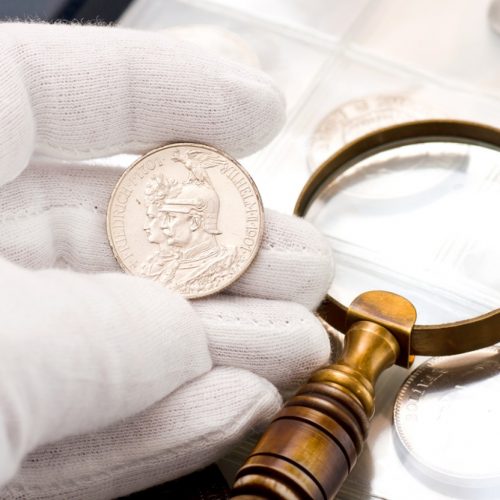
As technology has improved, coin counterfeiters have unfortunately improved the quality and believability of their fake products. According to the American Numismatic Association, counterfeit bullion coins are “flooding the market at an astonishing rate.”
A variety of metal alloys, including a percentage of precious metal, may be used in the creation of counterfeit coins to intentionally deceive buyers. Some counterfeits are made of base metals that have been plated with a precious metal. Even professionals who deal with coins every day might not be able to recognize some counterfeits on sight.
Investors have growing concerns about the authenticity of their precious metal holdings because of this counterfeiting issue. The best way to avoid compromising your investment is to buy bullion only from reputable and accredited dealers, like Provident Metals. However, there are a handful of simple ways to test the authenticity of your metals at home with a few basic supplies.
![]() Check the Dimensions and Weight
Check the Dimensions and Weight
Bullion coins and rounds are inscribed with their weight and purity, so the natural place to begin testing is to weigh the coins in question. Bear in mind that one troy ounce is equivalent to 31.1 grams, while one avoirdupois ounce is equivalent to 28.3 grams. Any difference between the inscribed weight and the actual weight on your scale may signify a counterfeit.
It’s just as important to check the coin’s dimensions with a digital caliper. Gold and silver are both dense metals, meaning that fakes with the correct weight will likely be too large in diameter and/or thickness. Or vice versa, coins may prove underweight in order to achieve the correct dimensions. You can easily find the a coin’s dimensions on the mint or manufacturer’s official site, allowing you to compare your own diameter and width findings. Any discrepancies may signify a fake.
![]() Take a Closer Look
Take a Closer Look
In addition to noting a coin’s weight and dimensions, you can also visually inspect coins for signs of design discrepancies. Using a high-quality magnifying glass or a jeweler’s loupe, begin examining the coin. You’re looking for details that might be missing or be placed in the incorrect position. Professional numismatists might already know what to look for, but many people find it helpful to first locate information online, including articles that discuss counterfeits of the coin you’re inspecting.
For example, almost all bullion coins bear a mintmark, so a missing mintmark might be suspicious. Most coins will also bear inscriptions of the weight, purity, year of issue, denomination, and sometimes a serial number. Compare these inscriptions to a close up image of the genuine coin from the mint or manufacturer’s website and check for details like font and spacing. Another area to check is the edge finish, which is often designed to be difficult to replicate. This type of visual inspection may not be fully conclusive, but it can help identify counterfeits (especially those with easy-to-spot design flaws).
![]() Use a Magnet
Use a Magnet
Neither gold nor silver are magnetic, so magnets can come in handy when testing a bullion coin’s authenticity. Place a strong neodymium magnet (also called a rare earth magnet) on a bullion coin or round. The magnet should not easily stick to the metal. In fact, if your coin and magnet attract each other, it’s almost certain that your coin is a fake.
Many counterfeit coins that do attract to a magnet are made primarily of iron. However, there are counterfeit bullion coins that are made with non-magnetic metals and can therefore pass the magnet test. Using the magnet test is a helpful tool, but it would be unwise to rely solely on this test.
![]() Put it on Ice
Put it on Ice
This test is specifically for silver coins and rounds, because silver is a strong conductor of heat. All you have to do is place an ice cube on top of your coin. Genuine silver will begin to melt the ice immediately due to its thermal energy storage. No melting or very slow melting likely means that you have a counterfeit on your hands.
![]() The “Ping” Test
The “Ping” Test
This test refers to the chime or ring that’s heard when a silver coin or round is struck with another metal. Balance a coin on your fingertip and, with another piece of non-abrasive metal , gently tap the coin (a light strike should not cause damage to your coin). Real silver will produce a high-pitched ring that lasts for a second or two. A “clunk” or other non-ringing sound might mean that your coin is not true bullion.
![]() A Chemical Reaction
A Chemical Reaction
If all previous tests are inconclusive, there’s one more test you can try at home (though we don’t necessarily recommend it). Acid test kits—which are inexpensive and very accurate—are available on the market for both gold and silver, though testing with acid permanently damages the coin that you test.
If you choose to perform an acid test, be sure to fully read the instructions that come with the kit and wear proper safety gear like gloves and goggles. Following the directions, apply the acid to your coin and observe the change in color at the application site. For silver, red, brown, or green confirm real silver, while any other color indicates a fake. Meanwhile, gold will not react or dissolve when exposed to nitric or sulphuric acid.
While an acid test can immediately verify if you’re holding real bullion or a fake, the damage done by the test is likely to devalue your coin. Additionally, the test may fail if your coin is made of an inner base metal that is heavily plated with gold or silver. For these reasons, we do not recommend this test for independent investors.
 The Solution: Buy from a Reputable Dealer
The Solution: Buy from a Reputable Dealer
It can be tempting to engage in private transactions, especially if you find a deal. However, these deals are often too good to be true. The best way to avoid buying counterfeit coins is to make your purchases through a reputable dealer. Provident Metals is a licensed and accredited business, with long-standing ties to renowned coin organizations like the American Numismatic Association and the Texas Numismatic Association. All of our bullion products are guaranteed to come in new condition directly from the mint, apart from the vintage coins and secondhand items we offer and clearly mark as such.
With Provident, you never have to worry about buying a counterfeit. You can trust us to sell the real deal every time!




Ordered $1300 worth of your Golden State Mint 1oz bars from you a few years back. Assuming they were from a reputable company (Bought from you, Provident Metals) I never bothered to check. Well with the rampit rise in fakes I decided to Assay my entire inventory.
Sure enough, the one batch that is in question is the one I thought I wouldn’t have to worry about (yours). I did (4) Test….passed but all but one (Ping/Sound Test). They are also large then other (1) oz bars.
What now, I bought from a reputable company (YOU) and now they seem to be in question. YES, I have the original invoices.
I purchased about $1300 worth of Golden State Bars from you company years back. Assuming they came from you, I didn’t test it (Yes, still have the invoices that came with them).
I decided to pull all my stash and test them, being fakes are running rampit. Well the (20) rolls I did not expect that would sound off, sure enough was the ones I least expected (Yours).
I’ve done the magnet test, I’ve done the Ping Test (Failed), I’ve weighed it, and did the ice test.
What now? I assumed purchasing from a reputable company as you say (Purchased directly from you) that I wouldn’t have to even think about them being fake. Also, what are you testing practices? Who mints the Golden State product? Who validated them? Am I possibly out $1300 now??
I got a Perth Mint 10 gram gold bar and the packaging is dark green, meaning it is very old, and there is a giant bubble around the bar, and the plastic is coming up all over the edges. I did not order a second hand bar. It was supposed to be new.
Hi Marjorie,
Sorry to hear about your experience. I encourage you to contact customer support; our skilled team can assist you further.
Another magnet test is the Lenz effect test. Take a genuine silver round and hold it at a little more than 45 degrees then drop a small neodymium magnet down the flat side of the round. The induced magnetic field in the silver round will make the magnet slide much slower than it otherwise would. Get a good feel for how this works with a genuine silver round and I doubt any fake could ever fool you on this test.
Great addition to the magnet test. Thanks for sharing!
What is “much slower than it otherwise would” and since when does a “rare earth magnet” or any other kind of magnet “induce” a magnetic field in non-ferrous metal like silver? You can only “induce” a magnetic field in FERROUS METALS SURROUNDED BY NON-FERROUS METAL “COILS”, CHIEF.
passive resistence offers some field resistence on movement dosen’t break the field nor attract to the field chief
this along with the water gravity test are the best absent the acid test
Ordered $1300 worth of your Golden State Mint 1oz bars from you a few years back. Assuming they were from a reputable company (Bought from you, Provident Metals) I never bothered to check. Well with the rampit rise in fakes I decided to Assay my entire inventory.
Sure enough, the one batch that is in question is the one I thought I wouldn’t have to worry about (yours). I did (4) Test….passed but all but one (Ping/Sound Test). They are also large then other (1) oz bars.
What now, I bought from a reputable company (YOU) and now they seem to be in question. YES, I have the original invoices.